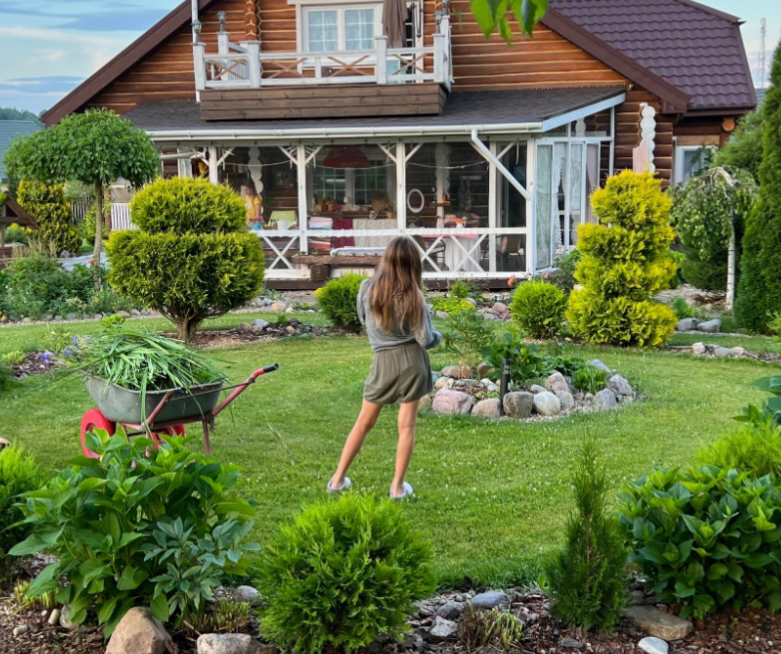Discover how to create a cottage garden filled with an abundance of flowers and charm. Follow these steps to transform your outdoor space. The point of landscape design is not only to make it “beautiful.” The project helps to conveniently arrange the area so that children have a place to play ball and adults can cook barbecue.
How To Create A Cottage Garden
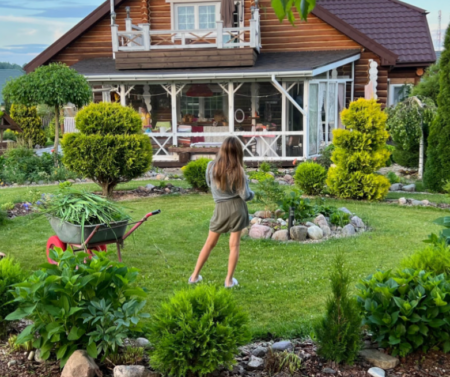
Popular landscape design styles
Landscape design, like interior design, has its own styles. Ideally, the site should be designed within the same style, so that different elements do not conflict with each other.
Modern and minimalism
The main features of this approach are simplicity, a minimum of details and a maximum of open space. Designers often use geometric shapes in a project, for example, to design flower beds, and instead of bright flowering plants, they plant strict greenery.
Typical materials are metal, glass and concrete. Smooth surfaces and simple textures. The style is somewhat reminiscent of Scandinavian design – calm, strict and discreet.
Classic
One of the signs of classicism in architecture is symmetry. It’s the same in landscape design: plants are arranged in rows or groups, and bushes and low trees are neatly trimmed. Flower beds can be divided into sections by color or variety.
Natural stone, marble or granite are used for paths and patio decoration. For fences and borders – wrought iron grilles or decorative bricks.
Rustic or country
Country looks organically next to brick and wooden houses. The style will appeal to those who love natural forms: symmetry, thoughtful composition and pretentious decor are not needed here. There are no strict rules; you can experiment, including with homemade garden decorations and furniture.
Variegated flowers planted together look good. Paths and flower beds can be framed with cobblestones, and any objects made of wood or clay can be used in the decor.
This is a practical style – not for beauty, but for life. An outdoor kitchenette, wooden loungers, tables or gazebos will always fit here.
Alpine
Signs of the style are dim plants from mountainous regions, stones and pebbles. When designing a garden, designers take care of the natural topography of the site and, if possible, do not level it. The famous alpine slide is a composition of flowers and stones at the highest point of the garden.
Most of the space remains open. Ponds and mini-waterfalls will look good in this concept. For functional elements, only natural materials are used – wood and stone.
Japanese and Chinese
Japanese gardens are usually minimalist. The most recognizable detail is the traditional compositions made of stones. Among the plants accepted are coniferous trees, cherries, maples and bamboo. Suitable shrubs and flowers include azaleas, hydrangeas and lotuses.
The Chinese garden is similar to the Japanese one; symbols of different elements are important here – water, stones, plants. When planning, the cardinal directions are taken into account and the composition is designed relative to the center. For the atmosphere of traditional China, decorative wooden bridges are installed.
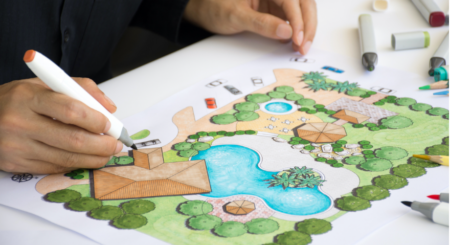
What to pay attention to
There is a list of popular elements that are most often placed on the site. But when preparing your own plan, it is better to discuss all your wishes with your family: maybe the children have long wanted a summer hut, but for the father-in-law, his own cucumber bed is important.
Places for rest . Benches, terrace, gazebo or wooden decking. This area will require furniture, sun-shading structures and large shading plants.
Barbecue area . The most important thing is to make it safe. By law, you cannot install a grill closer than 5 meters from buildings. There are also requirements for the distance to fences and trees. Don’t forget to provide space near the grill for firewood and fire accessories.
Lawns and flower beds . The grasses that make up the lawn must match the climatic conditions. Otherwise, you will have to admire withered, yellowed or sparse grass for most of the year. With flowers, consider seasonality: you can choose plants so that the flowers in the garden will replace each other without interruption from May to September. Keep in mind that some species grow over time, which means you need to leave free space around them.
Garden paths . Paths should lead to all key areas on the site. At the same time, it is ideal if they do not meander chaotically, but form a single figure. Style affects the shape of the tracks – smooth or, conversely, directed at right angles. A variety of materials are used: stone, wood, tiles. You can even simply fill the paths with crushed stone, gravel or sand.
Reservoirs . A stream, pond or pool can become the center of the site or fit into the natural landscape. In this case, it is important to consider filtration systems. Water features need to be maintained, so seriously evaluate the pros and cons in advance.
Lighting . The atmosphere in the garden and safety depend on the layout of the light. Distribute the light evenly to avoid tripping over a garden gnome at dusk. In addition to lanterns and outdoor lamps, you can use lighting for the facade, flower bed or pool. The table and barbecue should also have their own lighting.
Decor . Sculptures, fountains, flower pots, garden figures are optional elements that can nevertheless emphasize the design style. But it’s easy to overdo them. Pay attention to the quality of materials so that objects do not rust, peel or fade in the first season.
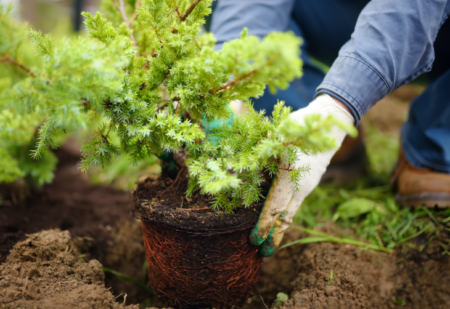
Work plan
Step 1. Zoning
Zoning means dividing the garden into functional and decorative areas: flower beds, clean lawn, dining and barbecue areas. Along with the zones, paths to the main structures and areas are planned.
Step 2. Form a concept
Together with a specialist or on your own. Determine the style, choose colors, plant varieties, lighting, finishing materials. Do not forget that the architecture and style of the house and other buildings on the site matter.
Step 3. Make a list of objects
Trees, flowers, decor, furniture, lighting systems. At this point, you can more or less finally evaluate the budget.
Step 4. Prepare the area
Before starting work, the area is cleared of excess trees and bushes, stones, and debris. Depending on the concept and natural conditions, the terrain is leveled, the soil level is changed, or the surface is left in its original form. At the same stage, it is worth checking the quality of the soil and, if necessary, adding compost or organic fertilizers to it.
Step 5. Install the main buildings and objects
Workers mark out the site, install paths, create artificial ponds, and form flower beds. They build terraces, gazebos, lay tiles, install awnings, and install electricity for street lights.
Step 6. Plant the plants
Plants are planted sequentially – from large to small. If you plan to organize a hedge or landscape the facade, the supports must be installed in advance.
Step 7. Install decorative elements and furniture
Select and place garden figures, garlands, furniture, flower pots and other non-permanent structures.
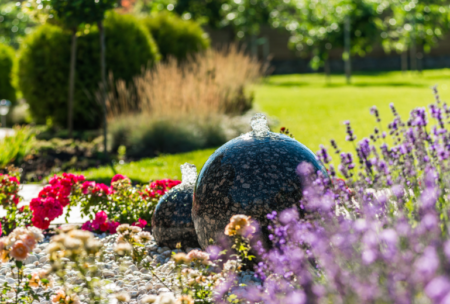
4 mistakes when planning To Create A Cottage Garden
Even if you are in a hurry, do not neglect planning, think through the landing in advance and do not put off the issue of lighting until the last minute.
Mistake 1: planning the site incorrectly or not planning at all
It is very important to take into account the size of the site and its features, plan the placement of all elements in advance, otherwise the space may turn out to be non-functional. For example, due to a disproportionately large flower bed in the center of the plot, you will have to place the grill right next to the fence, and there will not be enough space for some important items.
Another example: next to the lawn where children play, you should not plant fragile and whimsical plants. Don’t forget about the light and movement of the sun: the hammock where you planned to lounge with a book will be useless if the sun shines on it most of the day.
Mistake 2: decorating the garden independently of the house
This applies to both layout and design. When an outdoor kitchen is too far from leaving the house, carrying food and utensils back and forth is inconvenient. Opposite the living room windows, it is better to place a lawn for children to run around, rather than a sun lounger for daytime naps.
The appearance of the facade also matters. A house decorated with plastic siding is unlikely to combine with a rustic-style garden. In the same way, a multi-colored cottage will stand out from a classic or minimalist landscape. To ensure that your house and property match well, choose plants in a shade close to the color of the building, and do not plant trees near the house that are much taller or much shorter than it.
Mistake 3: overdoing the design
The more colors and elements, the more difficult it is to arrange them harmoniously in color and size. It’s better to choose no more than four main shades and ten types of plants. If possible, use the same materials on the site as in the facade of the house.
Mistake 4: choosing the wrong plants and planting them chaotically
The most common mistakes are combining varieties that bloom at the same time, as well as planting crops with different needs for light and watering in the same flowerbed. A planting plan is needed precisely in order to distribute plants in groups based on their needs: moisture-loving ones in the lowlands, shade-loving ones under the trees.
If you don’t have time to understand the characteristics of plants, draw up a layout, think through electrical wiring and irrigation systems, you can hire a landscape design specialist. A competent designer will help you save on mistakes: if the plants can be replanted or replaced next year, then moving the pond to another place or redoing the paths is more difficult and expensive.
